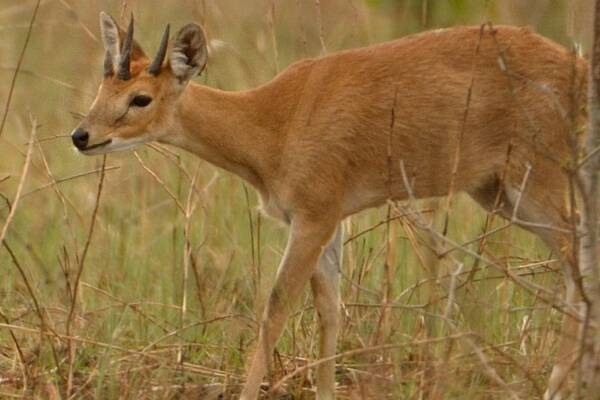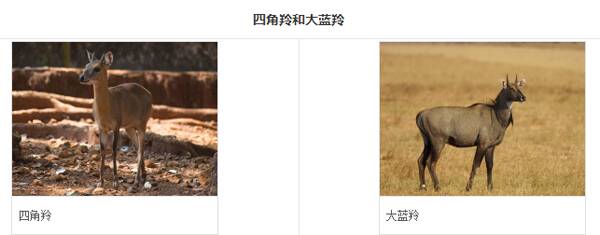Tetracerus quadricornis
IUCN
LCBasic Information
Scientific classification
- name:Tetracerus quadricornis
- Scientific Name:Tetracerus quadricornis
- Outline:Ungulata
- Family:Artiodactyla Bovidae Tetragonidae
Vital signs
- length:80-110cm
- Weight:15-25kg
- lifetime:About 10 years
Feature
The male has two pairs of horns on his head, two between the ears and one on the forehead.
Distribution and Habitat
It is found only in India and Nepal. It is widespread from the foothills of the Himalayas to the Indian Peninsula, but is more dispersed in most of India. Some of it remains in the Nepalese lowlands. In 2007, 122 sites were recorded where it was found, with most local extinctions occurring in the northern Gangetic plains and Maharashtra.
The four-horned antelope is mainly found in forested areas of India. The species is widespread throughout its range. It inhabits the edges of forests and grasslands, and mostly lives in rolling hills. It prefers open forests, tall grass areas, and dry deciduous mixed forests, and does not stray far from water bodies.
Appearance
The four-horned antelope is of medium size, with a body length of 80-110 cm, a shoulder height of 55-65 cm, and a tail length of 10-15 cm; it weighs 15-25 kg. It is sexually dimorphic. It has a small head and a narrow snout. Females are hornless; males have two pairs of horns on their heads, two between the ears and the other on the forehead. The rear pair is longer, 8-10 cm, conical, smooth in appearance, and slightly curved inwards. The front two horns are shorter, 2.5-3.8 cm, and sometimes only black fleshy bumps appear. Males grow the first pair of horns a few months after birth, and the second pair does not grow until they are 14-15 months old. They do not shed their horns, but they can be broken during fighting. The limbs are slender, the ends of the hooves are rounded, and the hips are high. The hair on the head is short, sparse, and coarse.
The snout, the outer edges of the ear shells, and the front of the limbs are all dark brown. The males have dark reddish brown upper bod
Details
There are three subspecies of Tetracerus quadricornis.

Tetracerus quadricornis do not live in groups, rarely more than two individuals are together. These animals are solitary, living in the same area for their entire lives. It is not known whether they are territorial animals. During the estrus period, males have been found to be extremely aggressive towards other males. The species is easily tamed when young, but is extremely vulnerable in captivity. The species density is estimated to be less than 0.5 individuals per square kilometer. The main diet is grass, shoots and fruit. It rarely strays far from a water source.
During the rutting period, males can be very aggressive. Mating occurs during the rainy season from July to September, and calves are born in January or February of the following year. The gestation period is 7.5-8 months. Usually 1-3 calves are born per litter, and calves weigh about 1 kg. Like all mammals, females of the four-horned antelope nurse their young. Although there is no information on the details of parental care in this species, it is common for even-toed ungulates to produce precocious calves.
The four-horned antelope and the blue antelope are similar in appearance and size. The difference is that there are two subspecies of the four-horned antelope (the nominate subspecies and the Nepalese subspecies have four horns).

As of 2016, the number of four-horned antelopes was estimated to be less than 10,000 mature individuals. Based on the loss of forest habitat, the inferred and predicted population size continues to decline, and no subpopulation is estimated to contain more than 1,000 mature individuals. The species has not been well studied, and more information is needed to fine-tune the population size and density distribution. It is possible that it is already close to endangered status.
The main threats to the four-horned antelope are the clearing of bushes and forests for agricultural development, which destroys habitats, leading to direct habitat loss and lack of connectivity between protected areas; and the compound effects of hunting and competition with livestock.
Listed in the IUCN Red List of Threatened Species in 2016 ver3.1 - Vulnerable (VU).
Listed in Appendix I, II and III of the Convention on International Trade in Endangered Species of Wild Fauna and Flora (CITES) 2019 version Appendix III.
Protect wild animals and stop eating game.
Maintaining ecological balance is everyone's responsibility!








